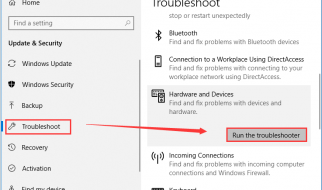Officially featured in GQIndia, Top 5 most upvoted on r/progresspics on May 12, 2018 ? 4 months progress

It was December 2017, I was fresh out of college and didn?t exactly look my best. I had been a chubby kid all my life but never quite got down to understanding why. My eating habits were like everyone else?s around me, I had a normal life and was busy studying books and working on computers to ?get ahead? in life.
While I?d done fairly well for myself, I ended up sacrificing several aspects of my life during my technical pursuits, especially fitness and healthy living. Being an aggressive and determined individual by nature, I decided to make a change which was long due. After 6 months of consistent:
- Clean Nutrition and Calorie Counting
- High Volume, Intense Lifting Routines
- Cardio and Callisthenics Circuits
- Ungodly amounts of YouTube videos, self doubt, sweat and tears
I brought about an incredible change in my life.
Standing at 5’8, I went from being fat and overweight at 87kg (190lbs) to being lean and ripped at 65kg (143lbs) with 10% bodyfat.
I?m the fittest I?ve ever been, record athletic measurements and no words can really describe the way I feel when I look at myself in the mirror ? It?s beyond exhilarating.
Here are some after photos, clicked mostly in May and early June.
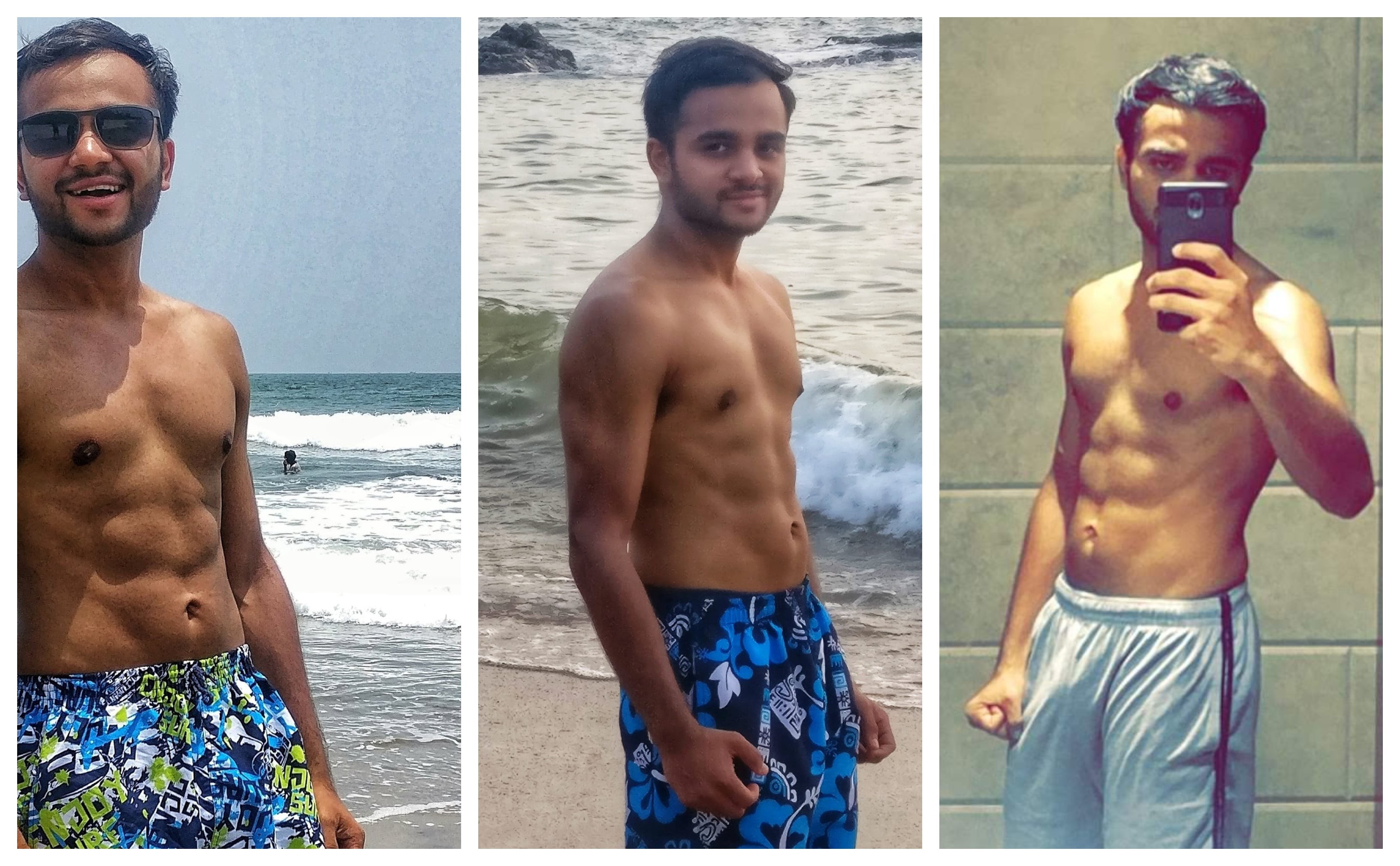 At the beach and before training
At the beach and before training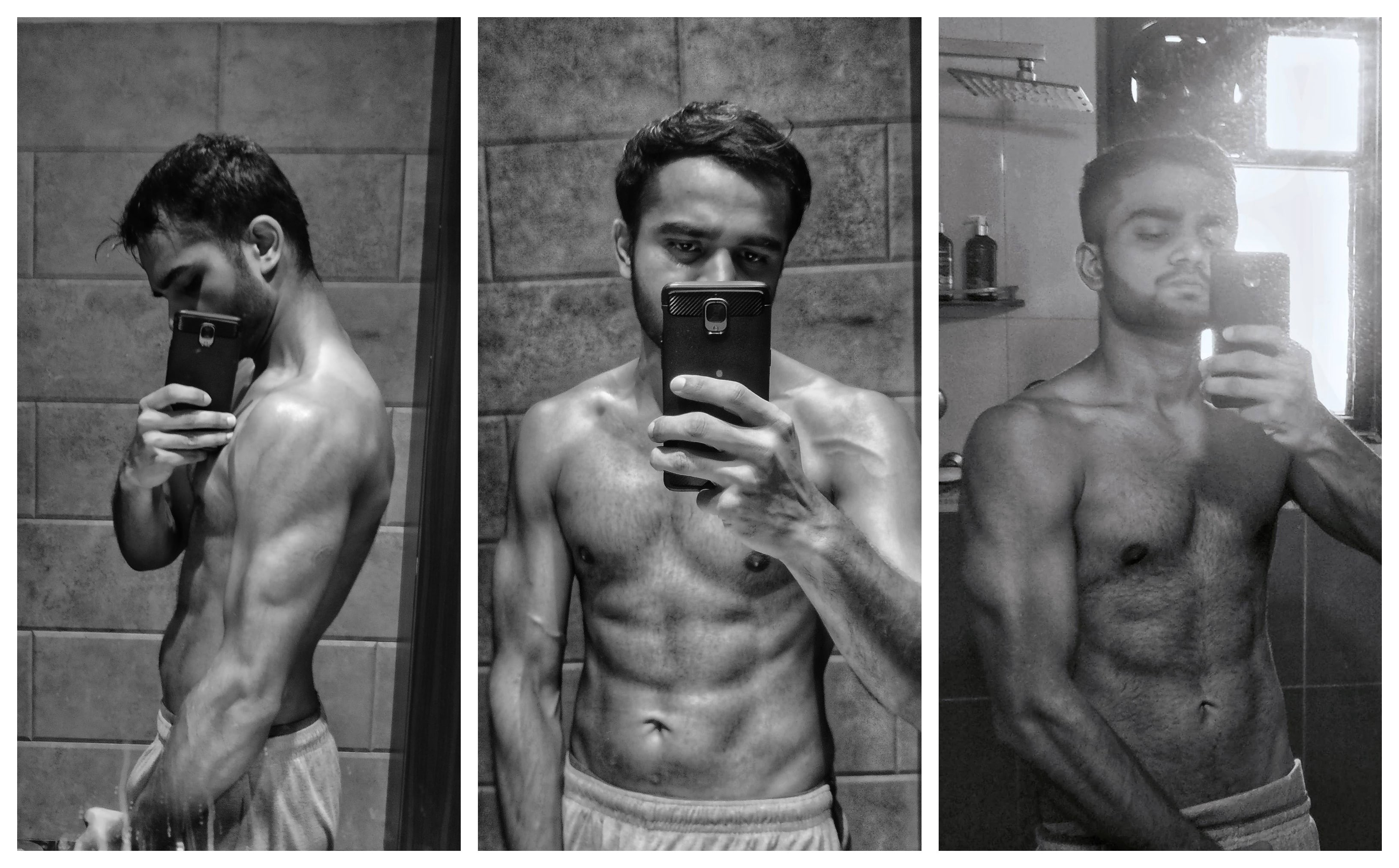 Some post workout shots where I look swole!
Some post workout shots where I look swole! In regular attire
In regular attire
I?ve had several friends ask me what I did and what they could do to get fit so I decided to nail down everything in this detailed article. I?ve also tried to bust a lot of ?six pack myths? in the process by backing them up with scientific explanations and relevant links wherever possible. Whether you?re fat, skinny or somewhere in the middle, I?m sure you?ll manage to takeaway something after reading this!
Understanding Your Body
- Humans are typically said to be categorised into 3 broad body types.
- Ectomorph ? That skinny, lanky friend of yours that can get away with eating anything and everything. They have a narrower frame and find it hard to gain fat as well as muscle thanks to their crazy metabolisms.
- Endomorph ? Bulkier and broader frame, typically a roundish-pear shaped body. They find it very easy to gain fat, especially around the belly area and stay that way. Not too hard to build muscle. I classify myself as an endomorph.
- Mesomorph ? Ah, the mythical mesomorph. They fall in between these 2 categories and ?naturally? have somewhat the ideal looking physique for their genders. Apparently, they lose fat easily, gain muscle easily and don?t really have to stress much about their foods either. In my opinion, perfect mesomorphs don?t really exist. Rather, they are built.
- The ?skinny fat? problem ? A lot of individuals suffer from the ?skinny fat? fat syndrome. They look seemingly normal, don?t have much fat on their face, arms or elsewhere but have a noticeable tummy. This happens when you have relatively low amount of muscle mass and a high percentage of fat. If you?re skinny fat, you probably eat a lot of carbohydrates (broadly, just ?not so healthy? food), very little protein and maintain a sedentary lifestyle. The fix is to maintain a caloric deficit, keep a high protein intake and focus on a body recomposition, which is exactly what I did. I?ll be explaining and describing everything in detail through the course of this article.
- BMI vs Body Fat Percentage- Body Mass Index or BMI calculates your ideal weight in relation to your height. This isn?t a great way of determining whether someone is healthy because it completely ignores how much muscle an individual holds. A better alternative is determining your Body Fat Percentage -BFP and then take a cue from your BMI as to how healthy you are. Here?s a visual comparison of how different body fat percentages look like. You can get your BFP measured by a Bio-electrical Impedance Scale found at gyms or at a nutritionist?s clinic.
Like I mentioned earlier, I never quite knew why I looked a certain way. Body types are determined by your genetics and that?s something you can do very little about. Some people can eat bad foods all the time and get away with it, others can?t (college is the perfect time to observe this phenomenon). The only way I could deal with this was to embrace my features, understand my body tendencies and eat as well as train accordingly.
Nutrition
Losing fat, staying fit and keeping healthy are factors largely determined by what you eat. It?s about 70% of the equation. I?ve tried to cover every detail regarding my nutrition here.
Basics
- Caloric Deficit ? To lose weight, you need to be in a caloric deficit (eat less). Every individual has a Total Daily Expenditure Value which is basically the number of calories (energy) your body needs daily to maintain it?s current weight. You need to consume lesser calories than your TDEE to be in a caloric deficit so your body can ideally tap into that stored fat for the extra energy it needs. Aim to lose anywhere between 2 to 5kgs a month. Anything more than that and you?re most definitely losing precious muscle.
- Protein ? The building block of muscle and that mystical term for most beginners. If you don?t consume enough protein while staying in a caloric deficit, you?re going to lose a lot of muscle mass along with that fat, drastically reducing your TDEE. More muscle means you can get away with eating more because muscles store glycogen which in turn give you energy. Also, more muscle makes you look more fab. Ever wondered why those people who go on a crash diet and lose a lot of weight gain it all back when they return to their old eating habits? Now you know!
- Body Recomposition ? This essentially refers to losing body fat and building muscle at the same time. Now, conventional wisdom dictates that you cannot do both at the same time . This however, is not entirely true. You can lose fat and build muscle at the same time if you are in a positive nitrogen balance (I just take this to be sufficient protein intake) OR you?ve never trained with weights before. When you first start lifting, your body is not used to the amount of wear and tear (shock) resistance training causes to your muscles. Because of this, your body amps up it?s testosterone (muscle building hormone) production to make sure it can keep up, resulting in some awesome newbie gains. These are highly accelerated periods of muscle growth right after you start training. It?s often said that the muscle you gain during your first 1?2 years of training is more than all of the muscle you can pack on in subsequent years combined. Seeing these quick gains is great as it?s extremely satisfying and motivating as a newbie.
- Carbs and Glycemic Index (GI)? Short for the term ?carbohydrates?, carbs are basically the fuel (again, energy) your body runs on. Bread, Roti, Rice, Sugar and even Vegetables are all forms of carbs. Most normal food we eat typically have some carbs in them. Now if you eat too many carbs, they get stored as fat. You want consume just enough carbs to get by and simultaneously assist your muscle tissues to grow through food. The solution is to eat ?good carbs? or low Glycemic Index foods (veggies, brown rice, oats, quinoa). The Glycemic Index(GI) is a scale that measures how close a food is to sugar. The lower the GI for that food, the longer it takes to digest, you remain full for longer, it releases energy slowly and doesn?t spike your insulin and blood sugar levels drastically, thus not hindering fat loss much. As a rule of thumb, low-GI foods are good foods while high-GI foods aren?t.
- Fats ?Fats get a bad rep. Fats are actually required for the normal and healthy functioning of your body. They key is to consume healthy fats from sources such as almonds and walnuts without going overboard. If your fat levels are low, it?s going to affect the testosterone levels in your body, affecting your gains. Also, if you completely eliminate fats from your food, your body starts converting all your carbs into fat and we all know where that ends up!
The combination of Carbs, Fats and Proteins is termed as macros (short for macro-nutrients).
The key is to feed your body the right amount of macros to meet your goals and nutrition requirements.
What I did
I focused on a body re-composition while switching to nutrition I could stick with long term. I?m not a fan of the word diet because it implies something short term. This was a change I intended on making permanently.
I absolutely despise the idea of a ketogenic diet because that?s something most of us can?t subscribe to for life. There are other popular diets besides keto like paleo and atkins that also demonize carbs and tell you that they make you fat. In my opinion, more food in general (which will invariably have more carbs) makes you fat, not carbs. Carbs are the basic fuel your body needs to function.
The key is knowing which, when and how many carbs to consume.
The following principles make up my present day nutrition habits.
- Avoiding all forms of sugar, refined flour and fried food ? The obvious first step to living healthy. Sugar and Refined Flour (maida) have a very high Glycemic Index and no nutritional value while Fried foods are super high in fat and incredibly calorie dense (even small portions are super high in calories).
- Intermittent Fasting(IF) ? Basically, skip breakfast and have only water/black coffee till lunch. In IF, you don?t eat for a period of 16 hours, typically skipping one major meal. You avoid spiking your insulin levels, your HGH is elevated and allow your body to tap into fat for energy. It also allows you to have a larger lunch and dinner, keeping you full longer for the rest of the day. IF is also shown to have various health benefits and is completely safe. Fun fact, even Terry Crews from the TV show ?Brooklyn nine nine? follows IF to stay ripped at 49. I followed IF for the first 3 months when I worked out in the evening. I also skip breakfast on treat days so I can eat a whole lot of food that evening!
- Restricting Roti and Rice intake ? Rice and Roti, two staple elements of a typical Indian diet are both forms of ?fast carbs? ? meaning they have a high Glycemic Index. They instantly spike your blood sugar levels and give you energy, which when not used quickly is stored as fat. Fast carbs in general tend to make you feel hungrier which results in overeating and subsequent weight gain (see carb crash). You want to severely restrict eating them and all their derivatives (poha, idli, dosa) in the earlier parts of your day while consuming them only in your pre-workout, post-workout or dinner. Consuming them before workouts gives you the energy to perform and consuming them after means you?re restoring muscle glycogen, refuelling your body and maintaining some sanity. Unfortunately, a typical Indian meal is rather high in carbs and very low in protein. No, lentils (dal/sambar) are not enough protein for you. Infact, they barely qualify. Nearly every other country?s staple food is centred around a source of protein (typically meat) along with some carbs on the side. In India, it?s the other way round. My theory is that this is the reason most folks fall under the ?skinny fat? category. It?s all due to imbalanced nutrition.
- Maintaining a high protein intake ?Maintaining a super high protein intake is imperative to ensure your body has enough to preserve existing muscle, ideally build more and also prevent muscle breakdown for energy while in a caloric deficit. I stuck to around 0.8 to 1 gram of protein per pound of bodyweight to ensure I allowed my body to not only preserve but grow muscle as well. For me, this came around to 130?140gms of protein a day.
- Carb cycling ? I followed a form of carb cycling where I would have low carbs, moderate fat and high protein on Cardio Days (Tue and Thu) and moderate carbs, low fat, high protein on Weight Training Days (Mon, Wed, Fri, Sat). I?ll explain why. On cardio days, you want your body to utilise as much energy as it can in the form of fat to burn without providing it extra energy from carbs. On weight training days, you need to have enough energy to push hard at the gym, replenish your muscles and providing them the food they need to grow.
- Calorie Counting ? I count my calories to make sure I?m on track everyday. I highly recommend the HealthifyMe app. They have an excellent database of food and dishes that you can select and track calories for. They also provide the exact macro breakdown for foods with a day-wise and week-wise analysis of your nutrition. I averaged out between 1500?1600 calories on Cardio Days and 1800?1900 calories on Weight Training Days.
- Supplementation ? It?s hard to get all your macros from food, especially while staying in a caloric deficit. More food means more calories, buying more ingredients, more cooking and lot many issues that you don?t really want to deal with on a daily basis. Supplements are called so because they are meant to supplement your nutrition and lifestyle, not act as a substitute. It?s imperative to find a fine line between the two for yourself and use them judiciously. I use the following supplements and have linked them to the exact brand, product and place I purchased them from. I am not paid to promote anything I?ve mentioned here. My sole motive is to tell you what I used and how it could possibly help you too.
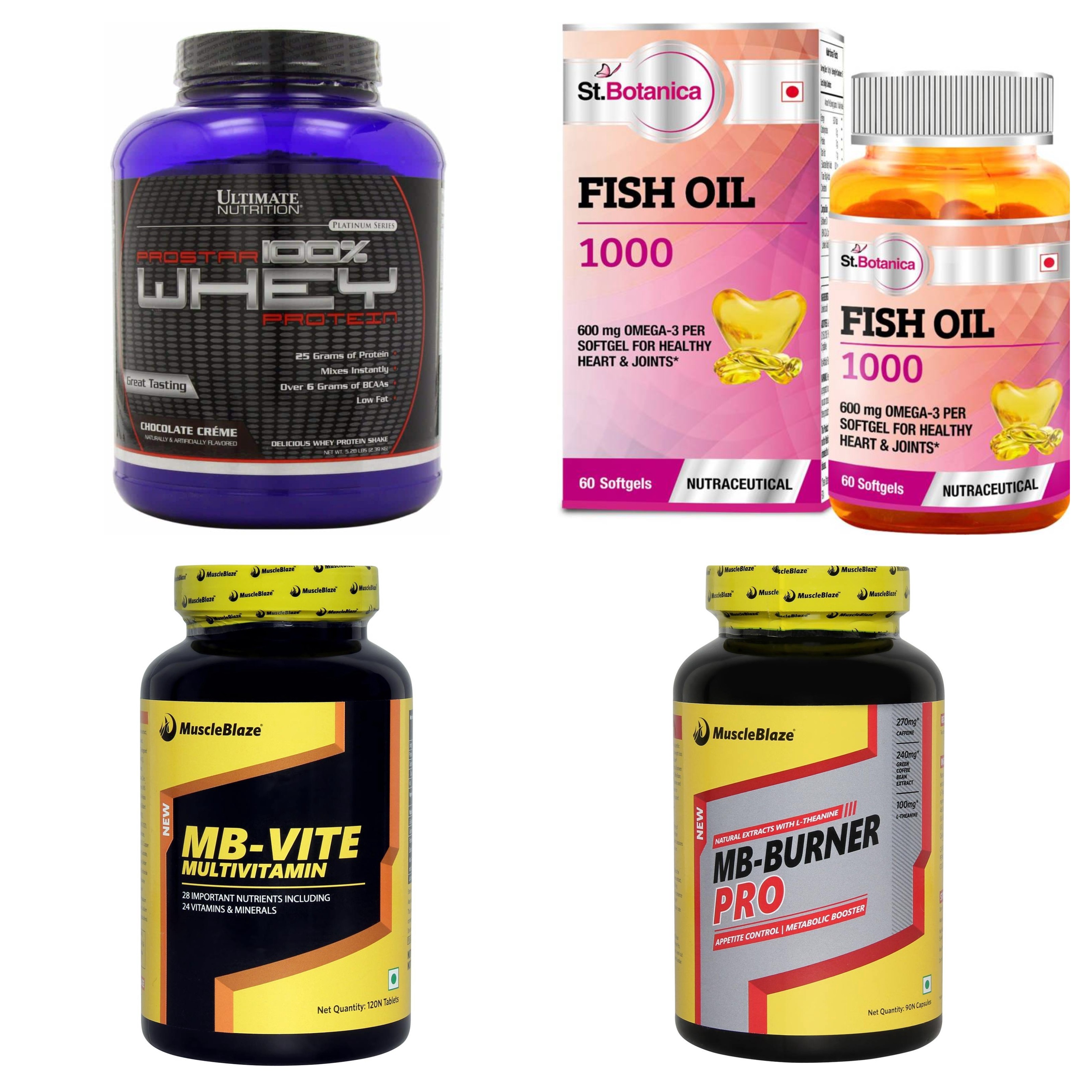 Supplements I used
Supplements I used
- Whey Protein ? Yes, it?s completely safe to consume good quality whey protein AND necessary in my opinion because they are quickly digested after a heavy workout, repair your muscles, help them grow stronger and allow you to push even harder at the gym the next day. The Indian market is flooded with fake supplements that contain dangerous chemicals and steroids which is where the fear of consuming them stems from. There have been reports where retailers on popular E-commerce websites have been accused on selling fake supplements. I recommend buying supplements from trusted brands and nutrition stores even if you have to pay a premium. I currently use Ultimate Nutrition ProStar 100% Whey Protein purchased from Nutrabay or Healthkart. If you?re just starting out and looking for a decent, cheaper option, try MuscleBlaze Whey Protein purchased from Healthkart. I used this for my second month of training after which I switched to my present one. I did not consume any whey protein during my first month of training but tried to get in as much protein as I could through food.
- Omega-3 Fish Oil Tablets ? I don?t really eat a lot of fish and Omega 3 has various benefits for your skin, overall health and even lifting. I use St.Botanica Fish oil capsules purchased from Amazon.
- Multivitamin Tablets ? When you?re eating less, you?re likely taking in lesser vitamin and nutrients than required. My doctor recommended I take these regardless so I went ahead and bought them without much thought. I use MuscleBlaze MB-Vite Multivitamins purchased from Amazon.
- Caffeine Pills ? I bought into the fad and purchased fat burners. Don?t use them if you workout in the evening because you wont be able to sleep all night and that?s going to cost you some gains. I barely used these in the first 3 months and then regularly for the next 2 (with the sole motive of finishing them). I didn?t really notice any significant difference as far as fat loss was concerned but I?ve noticed more intensity and focus in my workouts thanks to the high caffeine content. While I don?t wholeheartedly recommend them, use them alternately and only for morning workouts if you purchase them. A cup of black coffee is a far more natural and preferable alternative.
Meals
Here?s what my meals look liked. I worked out in the evening for the first 3 months, morning for the next 2 (as I moved to a different city) and then back to evening again. It?s only the timing of the meals that changes, the macros and daily calories remained pretty much the same.If you?re based out of Mumbai, I highly recommend HealthOnPlate?s services.
(If you?re a vegetarian, there?s something for you a little later!)
- Pre-Workout [Morning ? 6.30AM, Evening ? 6.30PM] ? scoop of Whey. This ensures you don?t lose muscle mass during your workout. On Cardio days, I consume nothing else but on Weight Training days, I have 1 slice of brown bread spread with Unsweetened, Natural Peanut Butter topped with 1 banana. It?s a solid combination of complex carbs and fruit sugar to fuel your workout.
- Post-Workout[Morning ? 8.00AM, Evening ? 8.00PM] ? 1 scoop of whey protein on all days.
- Breakfast (9.30AM) ? If you workout in the evening, nothing (IF). If you workout in the morning and it?s your cardio day, still nothing. On weight training days, 1 serving of Steel Cut Oats (why they?re better than regular oats) and skimmed milk, topped with some nuts and cinnamon powder. It?s imperative you replenish your muscle glycogen with some carbs post workout. I would usually cook 5?6 servings of oats on the weekend and store them in the refrigerator, using them through the week.
- Lunch (1.30PM) ? Around 250 grams of Roasted Chicken or Chicken Pieces with little curry along with a lot of veggies consisting of greens, carrots, broccoli and everything good. I spruce up this dish by sprinkling a seasoning made from a mix of chia seeds, sunflower seeds and flax seeds . Of course, there?s the occasional salad dressing and tandoori chicken. Here?s what lunch would look like on a normal day.
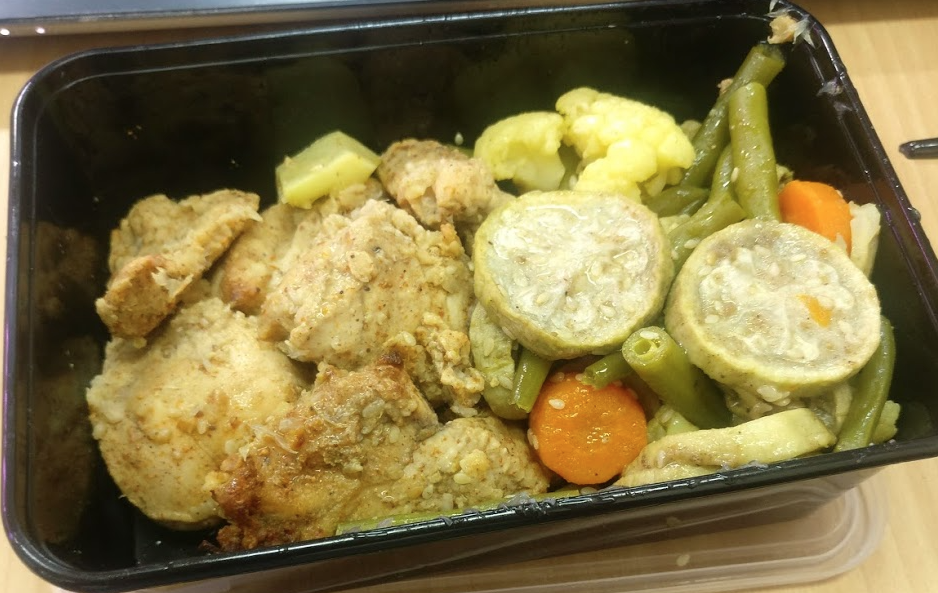 Roasted chicken with some eggplant and other veggies
Roasted chicken with some eggplant and other veggies
- Evening Snacks (5.00PM) ?1 scoop whey protein, 5 almonds, 3 walnuts. If it?s cardio day I mix a spoonful of peanut butter with my protein shake for some extra fat that satiates my hunger. I also keep a couple of reasonably priced Sugar Free Protein Bars in my bag in the rare cases when my hunger gets really bad or if I couldn?t manage a proper meal. There are some really expensive ones out there and while I?ve indulged in a few of them, the ones I linked to give me the best bang for buck and are also incredibly tasty.
- Dinner (9.15PM) ? Vegetables sauted in different masalas with some tomato curry, paprika seasoning and curd. Add different sauces from time to time for extra flavour. I load up on veggies while trying to get as many different colours on the plate as I can. For me, these usually are Broccoli, Bell Peppers, Beet Root and Zucchini along with regular ones like Spinach, carrots and cucumber. For weight training days, you want to introduce some carbs into your dinner. Initially, I stuck to Sweet Potatoes and Brown Rice but now occasionally have Roti, Rice, Brown Bread and even Pasta. On cardio days, I would add a cube of cheese or some paneer.
Here are 2 screenshots, my daily macro counts on cardio days followed by muscle training days. Remember, your requirements may be drastically different depending on your weight, height, body type etc.

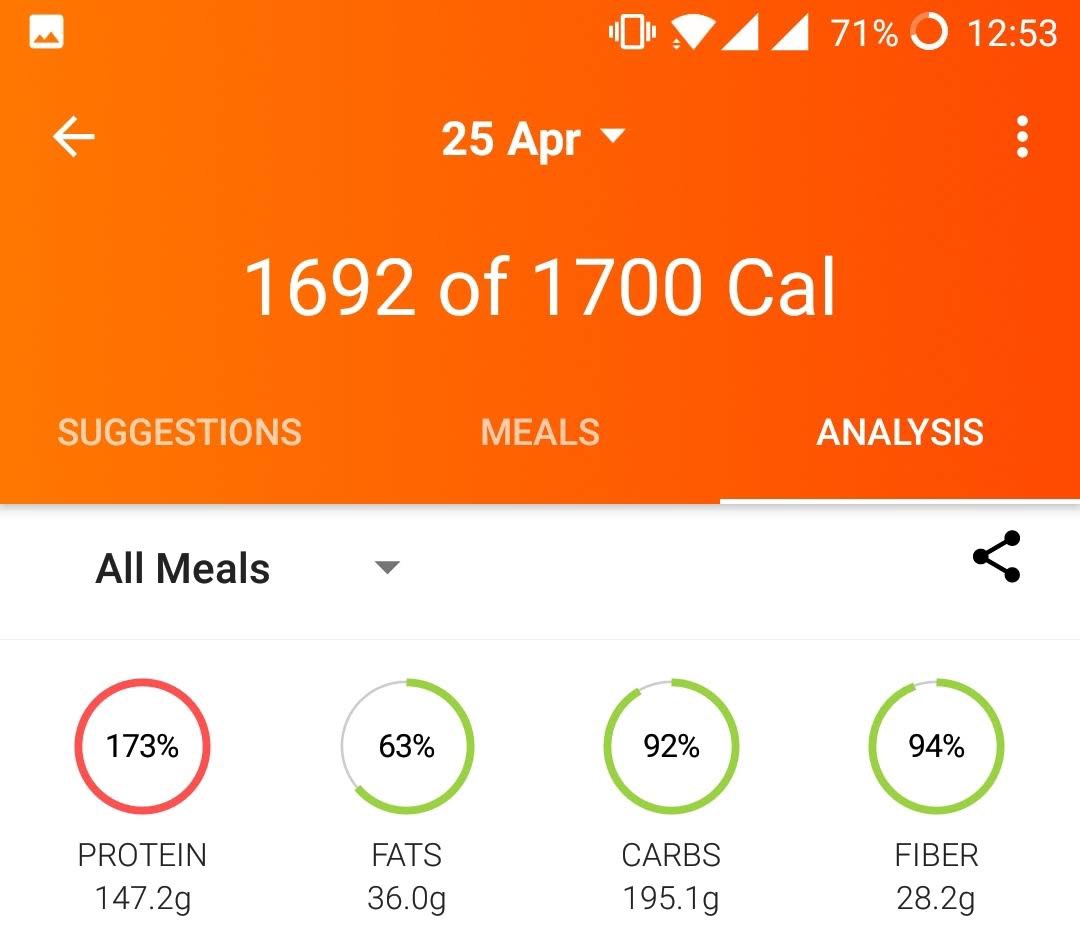 Calories on cardio days vs weight training days
Calories on cardio days vs weight training days
I have about 2 treat meals a week. ?Treat? sounds better than ?cheat? because after all, you?ve earned it! This is when I occasionally indulge in some beer, a slice of pizza, creamy pasta, something fried or maybe ice-cream. I?m a huge fan of Middle-Eastern cuisine so one of my meals over a weekend would definitely be a shawarma, a hummus platter and some kebabs on the side. I have a diet coke sometimes but mostly avoid all other soft-drinks including fruit juice (too much sugar, even the ?natural? variants). It?s imperative you make a conscious attempt to stay away from all of this on regular days.
Training
The gym is where you sculpt your physique while you?re losing fat during the rest of the day. ?Hitting the gym? will not get you your desired results unless you pair it up with solid nutrition like I described.
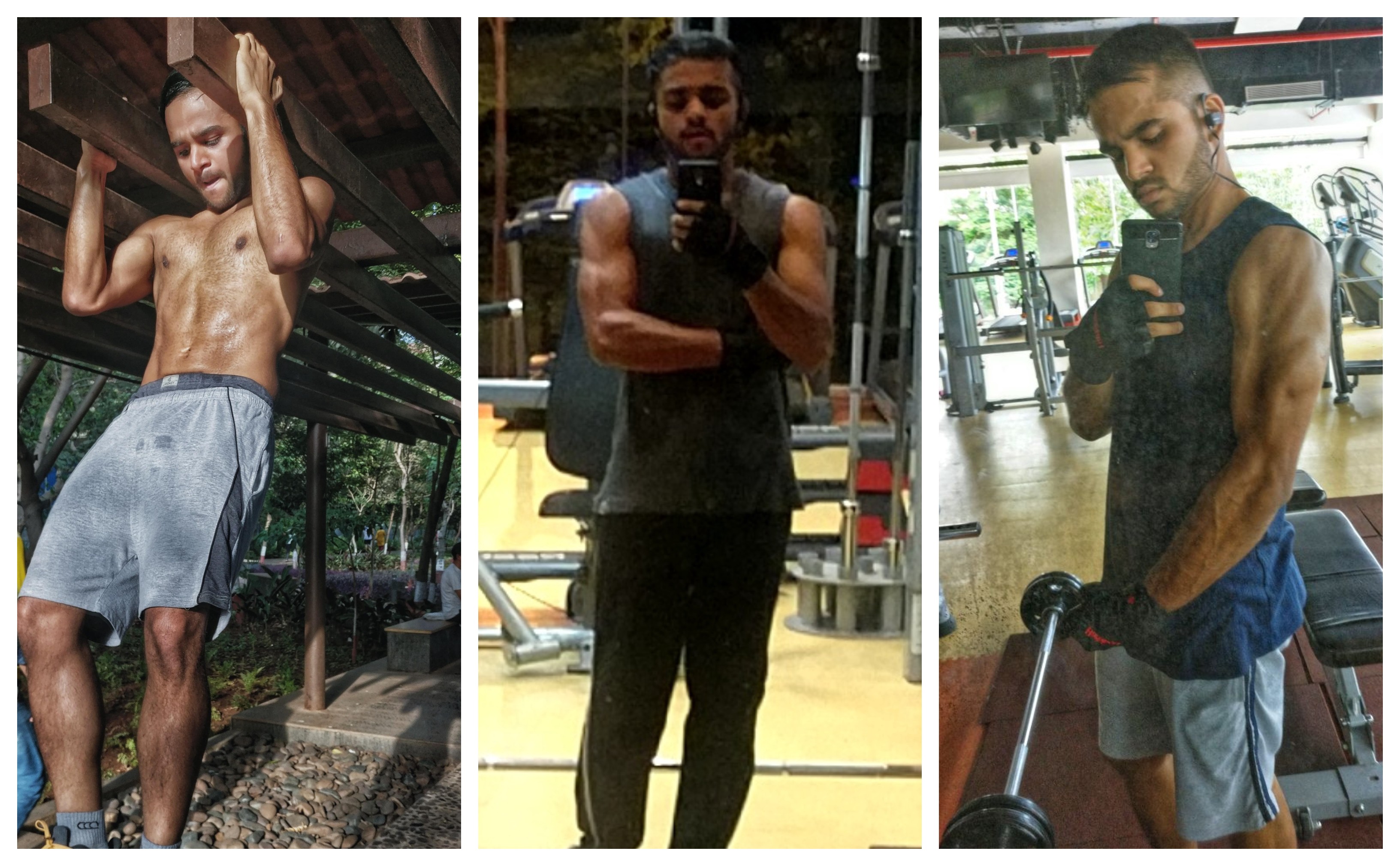 Few shots taken in-between workouts
Few shots taken in-between workouts
I train 6 times a week with the only goal of getting stronger, lifting heavier and beating my previous records. I aggressively subscribe to the concept of progressive overload where you constantly challenge yourself by increasing volume, intensity, weight or a combination of those 3. This is the only way to continue building lean muscle as someone natural (one who does not consume anabolic steroids or enhancement drugs). I keep notes on how heavy I hit an exercise previously and new exercises I would like to incorporate for each muscle group.
Contrary to what popular culture portrays, one does not need to lift really heavy if muscle hypertrophy, aka ?bigger muscles? or aesthetic gains are the primary goal (see bodybuilding vs powerlifting). One needs to ensure that a particular muscle is subjected to enough time under tension and training volume to ensure that muscle fibres are broken down and rebuilt stronger over time. This can be done by following a high-volume, moderately high rep range, moderate weight and low rest period lifting routine. I start off with 5 sets of a heavier compound lift eventually moving to isolation exercises. I started off with the popular ?3 sets of 10? for isolation exercises, then to 12 and now hit 4 sets with the rep ranges 15,12,10 and 8. Higher reps would mean a lighter weight and vice versa. My last set is almost invariably a dropset. I hit around 15 -18 working sets per muscle group per week.
I followed a split-based weight training routine spread over 4 days with 2 days for cardio. This is the training program I followed for the first 5 months which is something akin to the highly proven Push/Pull/Legs routine.
- Monday ? Chest + Shoulders
- Tuesday ? Cardio + Abs
- Wednesday ? Back + Bicep
- Thursday ? Cardio + Abs
- Friday ? Legs + Triceps
- Saturday ? Experimentation! Along with being a treat day, this is my favourite day of the week because I would target my weaker muscle groups when I felt they were lagging behind. For me, these were my Lower Chest, Biceps and Lats. I switch in other muscles from time to time.
- Sunday ? Rest.
Currently, due to time constraints, I do a bro-split while hitting 1?2 weaker muscle groups twice with a lot less cardio.
I try to ensure my form and posture is correct and verify the same by heading over to YouTube and clearly looking at the way every exercise is performed, taking screenshots. While I do cheat towards the end with heavy reps, I make sure I nail the first 4?5 perfectly. I also made it a point to not skip leg day. Exercising legs has incredible benefits like making you stronger on your compound lifts and releasing the maximum amount of testosterone.
My Cardio and Callisthenics circuits really helped me increase my stamina and perform like an athlete. Some of my favourite ones are Burpees, Crab Walk, Jumping Jacks, Jumping Squats, Kettle bell runs and in general, circuits variations that really push me to the limit. I followed an HIIT program on the treadmill where I would run for 2 minutes and walk for 1 for a total of 12 minutes. I used the preprogrammed interval training option on the elliptical and stepper machine. I also went to the park sometimes for my workouts. You?ll be surprised at how different and relatively harder it is to train in the open.
Sleep ? This is as important as your nutrition and training. Proper sleep is imperative for muscle recovery and growth. I get 7 hours of sound sleep daily.
Guidance
I?ve spent a lot of time reading articles and watching YouTube videos. There are a few online personalities I owe immense gratitude to and feel that everyone would benefit from their content in one way or the other. As far as I know, all of these individuals are natural and are not on any enhancing drugs.
- AthleanX ? If I were to recommend you ONE channel, this would be it. Don?t watch anything else, just listen to Jeff Cavaliere. His entire approach towards fitness is something that has come to resonate with me. There?s no bulking-cutting nonsense, pure focus on form, getting the maximum out of each exercise and a lifelong approach towards good, sustainable nutrition. If I wanted a few exercises to target a particular muscle group, this is where I go to first, learn them, try them out in the gym and invariably get results. There?s a ton I?ve learnt from Jeff and couldn?t thank him enough.
- BeerBiceps ? Excellent channel to watch as a beginner and a must watch channel for Indians. There?s plenty of content here that caters to Indian nutrition, training, vegetarians, grooming, healthy living and much more. Also, Ranveer comes across a normal, genuine dude without all the BS.
- Guru Mann ?The father of Indian YouTube bodybuilding and fitness channels. Has a formidable build after years of lifting. Great nutrition product reviews, sample workouts and advice for Indians. Much respect.
- HodgeTwins ? Jacked twins with ?all kinds of gains?. Their sense of humour grows on you. Fun channel where I had plenty of my noob questions answered. Good advice in general and one of the channels I watch the most.
- Vitruvian Physique ? Igor has the perfect combination of a big and lean body. Comes across as a super fun guy. Explains every concept by digging deep into science and research. Long videos and lots of memes.
- Yo Elliot ? Elliot Hulse is a no-nonsense, experienced powerlifter who gives solid advice regarding training and everything related.
- Scott Herman ?Scott is experienced and all round great guy with a nice natural physique. If you?re looking to nail that perfect form for a basic exercise, you?ll probably find a video for that here.
Questions I Get Asked
I?ve tried to make sure I included all the essentials details for someone to form their own judgement. Nonetheless, I get asked a specific set of questions time and again. I?ve tried to answer some of them here.
Q. ?Can you suggest me a diet for Vegetarians??
A. I?ll be honest, building muscle as a vegetarian is hard. There are nearly no clean sources of protein in a vegetarian diet. Soya Chunks come close but I?d recommend you stay away from a lot of soya if you?re a male due to it?s high oestrogen content. You can try incorporating more Beans (especially Rajma), Chickpeas, Hummus, Lentils (Dal), Sprouts, Tofu, Milk, Cottage Cheese (Paneer) and Cheese into your daily foods. Unfortunately, all of these foods either have higher carb content or higher fat content as compared to their protein content. Stick to the low fat or ?made from cow milk? variants.
I recommend vegetarians 2 ways out:
- Be content with slow but definite progress ? It?s near obvious your meals are going to contain more fat, more carbs and lesser protein than a meal which has meat. However, if you think you can make this work long term and are willing to commit yourself, you will definitely see amazing progress. Just make sure you?re in a slight caloric deficit (or surplus, if you?re underweight), consume sufficient protein (atleast 0.5gms of protein per pound of bodyweight) and hit the weights hard.
- Spend a lot of money on expensive supplements and food ? There are plenty of (rather expensive) supplements like plant protein powders and vegetarian meal replacement shakes. You might have to substitute more of solid food for these supplements to hit your ideal macro goals. As a vegetarian, you?re also not going to get in a lot of BCAAs through food so you might have to supplement with them separately. I?m not the one to tell you whether this is a good idea or not. If you can afford purchasing fancy food and supplements frequently, up to you.
Q. ?What to do if all I want to do is lose fat? I don?t care about muscle.?
A. In my opinion, this is the wrong mindset to be in. You?re probably only going from being a ?big potato? to a ?small potato?. However, following a good nutrition plan in a caloric deficit with sufficiently high protein intake will ensure you lose weight while the protein helps you preserve muscle mass.
Q. ?Does staying fit really have to be this expensive??
A. Well it doesn?t have to be. I obviously can?t match the stuff fitness professionals, models and actors do. I try to do the most I can in aspects I can control and so should everyone. Don?t stress over things out of your control. Accept them, embrace them, leverage them and become the strongest version of yourself you can. What?s the worst that can happen? It?ll take a little longer? Meh. In the end, it will all be worth it.
For me personally, all of this has been very heavy on the wallet. I nearly went broke at one point as I was still a student. Being fit and getting these results in such a short time has had a price to pay physically, mentally and monetarily. While I loved the grind, you may not.
Q. ?Can I include <insert food> in my diet ??
A. If you?re someone who just can?t do without eating something, by all means don?t give it up. I personally find it very hard to let go of bread completely so it?s a part of my daily meals. A rule of thumb to follow is ?IIFYM-If It Fits Your Macros?. This allows you to be flexible with the food you eat while making sure it doesn?t impact your overall nutrition requirements.
Q. ?Is <insert supplement> good/useful/effective ??
A. I make it a point to only recommend items I have personally used and benefited from. If I haven’t mentioned a supplement, product or service here, I don?t use it. Unless you have extra cash on you, I?d just stick to the essentials.
Q. ?Why don?t you look like <insert model or actor>? / You look skinny?
A. Unfortunately, most people don?t have the right notion of what a natural six pack or a lean body looks like. We?re so constantly fed images from magazine covers and movie posters, it?s hard to lose sight. These people use various editing techniques, strategic lighting and poses to get the best shots and convince us that that is what muscular men look like which is not true. Many popular Hollywood/Bollywood actors resort to consuming anabolic steroids and drugs which is the reason they look absolutely shredded for a particular film. The on-screen muscle you see on them is easy 10+ years of hard earned gains for natural individuals. Try comparing an actor?s in-film photos to photos taken a year or two afterwards. You?ll know what I?m talking about. If you want to look big/buffnaturally, you need to put on some fat, potentially losing your abs and muscle definition in the process. As for the ?skinny? issue, the problem is so many people are overweight these days that that?s become the new ?normal? so when they see someone with a healthy, lean body composition they think it?s skinny. This issue should go away over time when one builds more lean muscle.
But wait! I?m not saying you just can?t look like ?that?. It?s about getting the right combination of a workout pump (notice the most muscular guys in posters are always at the gym), flex, good lighting, the right angle and decent editing skills for a killer photo. Here?s my sloppy attempt at one!
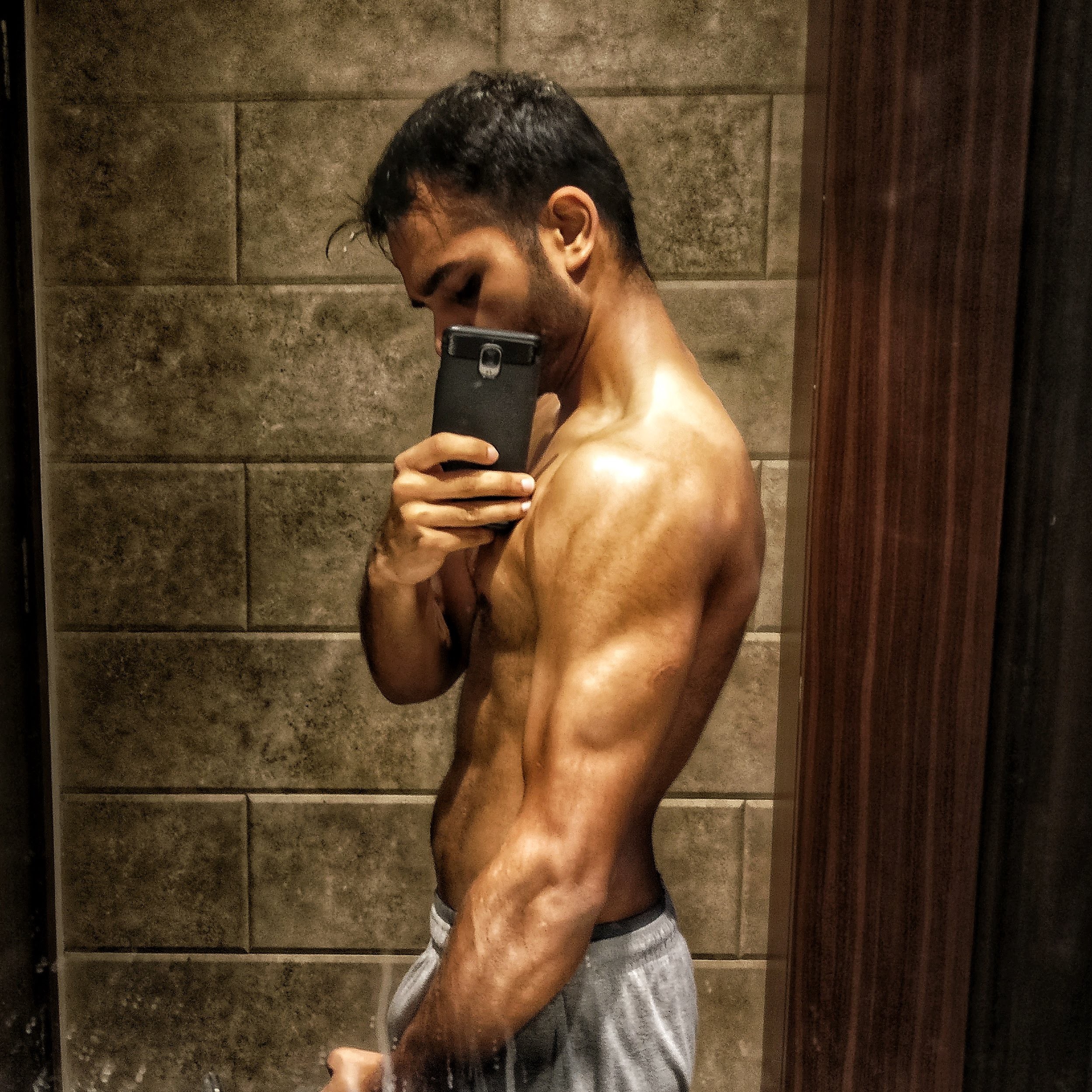
Q. ?Are you still on a diet / Will you ever go back to ?normal? food / Is it hard to maintain a six pack??
A. Like I said, I personally don?t believe in dieting. It?s about consuming good foods while being smart about consuming the ?lesser good foods? by having them in sensible quantities at the right time. I?m all for having an ice-cream once in a while and don?t hesitate in enjoying an entire (small) serving after which I slightly adjust my meals the next couple of days, skip breakfast and do a little more cardio. Really depends but it all finally averages out.
?Normal food?, or say a roti,vegetable subji, dal, rice is extremely imbalanced nutrition in one meal and that?s why I will never go back to it. I?m grateful that my family understands and accepts this. I?m substantially more flexible with my food now and don?t just live on chicken and veggies like I did at one point but ensure I get a balanced serving of macros in every meal. Indian food can definitely be be tweaked to this, just requires some added effort.
Maintaining a six pack is not hard when you?ve spent half a year?s worth of resources sculpting them while learning about what?s good for your body and what?s not. I don?t really feel an urge to consume junk food anymore, subconsciously make good food choices and enjoy training more than ever before. The entire fitness industry seems to have been built on convincing us that getting a six pack is the hardest thing ever but at the end of the day, it all boils down to your consistency at making good decisions.
In Conclusion
My only goal from day 1 was to ?get a six pack in 6 months, no matter what it takes?. Achieving this in such a short time pushed me to the limit and it took everything I had in me to overcome the doubt and succeed. There have been a lot of times when I would genuinely doubt my genetics (do I even have abs?) and confidence, struggle with weight loss plateaus and battle with waves of depression. All of this while juggling a couple of the most challenging professional jobs and projects I had encountered yet.
I?d stand outside restaurants pretending to stare at my phone while my family and friends munched on dessert. There would be days when I would be completely broken from the inside-out after training with weights in the morning and running a 2k in the evening on no fuel. I?d find excuses to stay at home on the weekends and give up meeting friends only to stay away from food and drinks which didn?t align with my goal. I got used to awkward situations while placing ?weird? food orders at restaurants and stares from coworkers while shaking up my protein mix.
?Was it worth it?? ? ?The journey? Yes, absolutely. A thousand times over?
Sure, the obvious benefits that you think and know are all there. I?ve noticed a definite change in the way people interact with me, increased attention and an incredible surge in confidence. What really matters is that I proved to myself I could achieve anything I wanted to if I truly put my mind, heart and soul into it while setting the right precedent for more ambitious things in the future.
My only goal through this article is to inspire folks around me to get fit, eat better and live a healthier lifestyle. I could never judge or put someone down on the basis of their appearance because I?ve been at the receiving end of this far too many times in the past.
What?s next ?
After having achieved this goal, there?s a seemingly big void in my life. I intend to fill it up with another ambitious goal instead of more training, though the latter is far more tempting! I find that training, staying fit, and eating right fits in very well with my lifestyle. I intend to keep it that way while being content with slow but lean and steady gains over time. I do intend on dabbling in boxing and advanced callisthenics in the future.
If you?re wondering what my motivation was, here goes???About 2 years ago, I came across this article???Debarghya Das-My Transformation: How I lost 66 pounds and gained a 6 pack in 8 months. Oh boy, I was zapped. I told myself this is what I?m going to do, but in my own way and the best way I can. Looking back, I think I managed to stay true to myself. I?ve been incredibly lucky to connect with him today and tell him how much his journey inspired me everyday. I probably wouldn?t be writing this today if it wasn?t for him. Thank you deedy!
Thank you for reading! I hope my story inspired you or someone you know to lead a healthier lifestyle. If I haven?t covered anything specific in the post that you?d like me to, let me know in the comments section. If you?d like to get in touch, feel free to email me!


